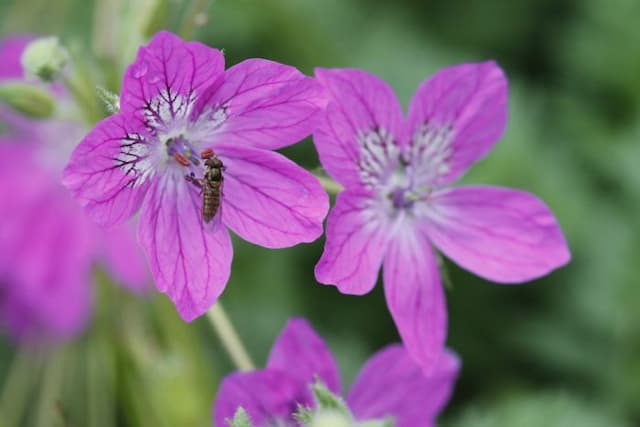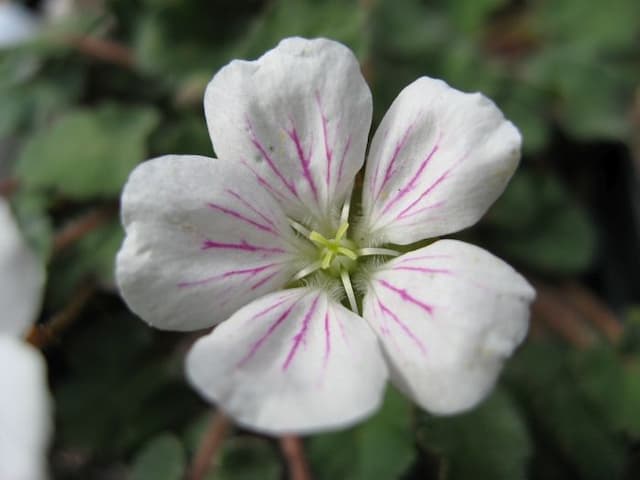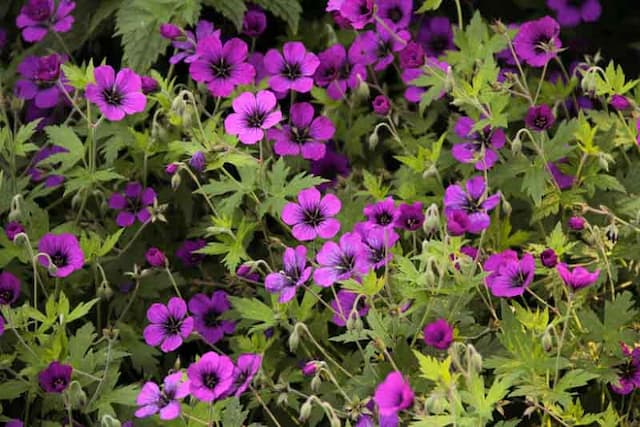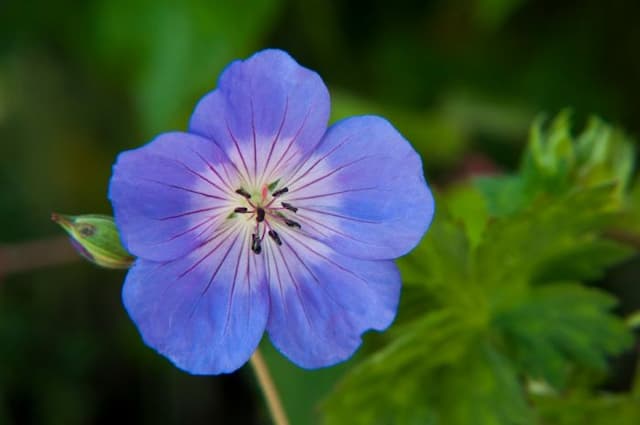Cranesbill Geranium 'Sirak'

ABOUT
The Geranium 'Sirak', commonly known as a cranesbill geranium, is a visually striking plant known for its beautiful and profuse flowering. This perennial showcases rounded, slightly lobed leaves that are medium green in color, sometimes exhibiting a reddish tint during the fall for added visual interest. The foliage forms an attractive backdrop for the blooms. The flowers of the Geranium 'Sirak' are particularly noteworthy, with their delicate and airy appearance. Petals are typically lavender-pink and boast a fine, darker veining that creates a textured pattern across the flower's surface. The veining adds depth and contrast, drawing attention to the intricate nature of the blooms. Each flower consist of five petals that are rounded and slightly overlapping, often with a lighter or white center where they attach to a slender flowering stalk. The overall flowering display of Geranium 'Sirak' is often described as cloud-like or frothy, with numerous blossoms forming clusters that float above the foliage. This plant can have a graceful and casual appearance, often lending a cottage garden aesthetic to its surroundings. The blooms are borne in loose clusters, and when in full bloom, they can create a soft and romantic visual effect. Long-lasting flowers of the Geranium 'Sirak' attract pollinators such as bees and butterflies, adding a dynamic element to the garden as these creatures visit. Once flowering has ceased, the plant remains an attractive mound of foliage that continues to contribute texture and color to the garden palette. The Geranium 'Sirak' is appreciated for its extended blooming period, providing continuous garden interest throughout the growing season.
About this plant
 Names
NamesSynonyms
Sirak Cranesbill, Sirak Geranium.
Common names
Pelargonium 'Sirak'
 Toxicity
ToxicityTo humans
Geraniums, including the 'Sirak' variety, are not considered highly toxic to humans. While they are generally regarded as safe, ingestion of these plants can occasionally cause minor symptoms such as nausea, vomiting, or diarrhea in some individuals. It is always recommended to keep plants out of the reach of children who may inadvertently taste or consume parts of the plants. It is important for individuals to avoid eating any plant materials if they are unsure of their edibility or safety.
To pets
Geraniums may pose a risk of toxicity to pets, particularly to cats and dogs. If a pet ingests part of a geranium, symptoms could include lethargy, vomiting, anorexia, and dermatitis. In cats, geraniums can also cause depression of the central nervous system. Pet owners should monitor their animals and prevent them from accessing plants that could potentially cause harm. If ingestion occurs, it is advisable to contact a veterinarian.
 Characteristics
CharacteristicsLife cycle
Perennials
Foliage type
Deciduous
Color of leaves
Green
Flower color
Lavender-pink
Height
1-2 feet (30-60 cm)
Spread
1-2 feet (30-60 cm)
Plant type
Herb
Hardiness zones
4-8
Native area
Caucasus
Benefits
 General Benefits
General Benefits- Attractive Flowers: Geranium 'Sirak' blooms with beautiful lavender-pink flowers that can add aesthetic appeal to gardens and living spaces.
- Drought Tolerance: Once established, this plant is relatively drought-tolerant, making it suitable for low-water gardens or for gardeners who prefer plants that require less frequent watering.
- Easy Maintenance: This variety of geranium is known for being low maintenance, which is perfect for both novice gardeners and those who do not want to spend a lot of time on garden upkeep.
- Pest Resistance: Geraniums are generally resistant to a variety of common garden pests, reducing the need for chemical treatments.
- Long Blooming Period: 'Sirak' can have a longer blooming season compared to many other perennials, often providing color throughout the summer months.
- Attracts Pollinators: The flowers attract pollinators such as bees and butterflies, which are beneficial for the garden ecosystem.
- Edging and Border Plant: It can serve as an excellent border or edging plant due to its compact growth habit, clearly defining garden spaces and paths.
- Versatile Planting Options: Geranium 'Sirak' can thrive in a variety of soil types and can be planted in flower beds, containers, and as ground cover.
- Color Variation: The color of the flowers can provide a soft contrast to bolder hues in the garden, offering a soothing visual experience.
- Foliage Interest: Aside from flowers, its foliage also contributes to the visual interest of the garden with its textured leaves.
 Medical Properties
Medical PropertiesThis plant is not used for medical purposes.
 Air-purifying Qualities
Air-purifying QualitiesThis plant is not specifically known for air purifying qualities.
 Other Uses
Other Uses- Geranium 'Sirak' can be used as a natural fabric dye, offering shades from soft pink to vibrant purple depending on the mordant used.
- The leaves of the Geranium plant may be infused in water to create a fragrant rinse for linens or clothing, imparting a fresh, floral scent.
- Petals of the Geranium can be pressed and used in botanical papermaking or to embellish homemade papers for a decorative touch.
- Dried Geranium leaves and flowers can be incorporated into potpourri mixes to add color and a subtle rosy scent to a room.
- The robust scent of Geranium leaves makes them an ideal natural insect repellant when crushed and rubbed onto skin or clothing.
- Baked goods can be adorned with crystallized Geranium petals for an edible and attractive garnish on cakes and desserts.
- Geranium plants can be grown as companion plants in the garden to help deter pests from more vulnerable plants.
- The flowers and leaves can be used to infuse sugars or syrups, providing a unique flavoring for teas, cocktails, or baking.
- When planted in outdoor seating areas, Geranium 'Sirak' can create a pleasant atmosphere with its aroma and vibrant blooms.
- Geranium blossoms can be frozen in ice cubes to add an aesthetic and flavor twist to summer drinks and punch bowls.
Interesting Facts
 Feng Shui
Feng ShuiThe Geranium is commonly used in Feng Shui to promote positive energy and balance within a space. Its bright flowers are believed to invite happiness and good health, while its green leaves represent growth and renewal. In Feng Shui, placing Geraniums in the wealth corner (southeast) of your home or office can help enhance abundance and prosperity.
 Zodiac Sign Compitability
Zodiac Sign CompitabilityThe Geranium is not used in astrology practice.
 Plant Symbolism
Plant Symbolism- Unity and True Friendship: The geranium symbolizes strong bonds between friends, suggesting fidelity and platonic love.
- Good Health: Often associated with wishes for good health, geraniums can be a metaphor for wellness and recovery.
- Positive Spirits: It's believed that geraniums promote positive energy and can dispel negativity, leading to improved mental well-being.
- Happiness and Good Fortune: Geraniums are also seen as bearers of happiness and are thought to attract good luck to a household.
 Water
WaterFor the Geranium 'Sirak', commonly known as cranesbill, it is important to water the plant moderately, ensuring that the soil is kept evenly moist but not waterlogged. During the active growing season in spring and summer, watering once a week with approximately 16 ounces of water per plant should be sufficient. During the cooler months, reduce watering to every other week as the plant's water needs decrease. Always check the top inch of the soil; if it feels dry, it's time to water. Avoid overhead watering to prevent leaf and flower diseases and water at the base of the plant instead.
 Light
LightCranesbill Geraniums thrive in conditions where they can receive full sun to partial shade. A spot that provides morning sunlight and some afternoon shade would be ideal. Ensuring adequate light can help the plant produce the vibrant blooms it is known for. The best lighting scenario is to place your Geranium 'Sirak' in a location where it can enjoy at least 4 to 6 hours of sunlight daily.
 Temperature
TemperatureCranesbill Geraniums prefer temperate conditions and thrive best in temperatures ranging between 65 and 75 degrees Fahrenheit. They can tolerate temperatures as low as 50 degrees Fahrenheit and as high as 80 degrees Fahrenheit. It is crucial to avoid exposure to temperatures below 32 degrees Fahrenheit, which can cause severe damage or kill the plant.
 Pruning
PruningPruning Cranesbill Geraniums is done to encourage bushier growth, remove spent blooms, and rejuvenate the plant. It's best to prune in early spring to shape the plant and remove any dead or damaged foliage. Deadheading, or the removal of faded flowers, can be done throughout the blooming season to promote continuous flowering. Cut back the entire plant by one-third after the initial wave of flowering to encourage a second bloom period.
 Cleaning
CleaningAs needed
 Soil
SoilCranesbill 'Sirak' thrives best in well-draining soil enriched with organic matter. A soil mix with equal parts of loam, peat, and perlite or sand is ideal. The pH should be slightly acidic to neutral, ranging from 6.0 to 7.0 for optimal growth.
 Repotting
RepottingCranesbill 'Sirak' should be repotted every 2 to 3 years or when it outgrows its pot to ensure sufficient space for root growth and nutrient absorption. Spring is the best time to repot.
 Humidity & Misting
Humidity & MistingCranesbill 'Sirak' prefers moderate humidity levels but is quite adaptable and can tolerate the drier conditions found in most homes. It is important to avoid overly humid conditions to prevent fungal diseases.
 Suitable locations
Suitable locationsIndoor
Place Cranesbill in bright, indirect light and avoid overwatering.
Outdoor
Choose a sunny spot with well-draining soil for Cranesbill.
Hardiness zone
4-8 USDA
 Life cycle
Life cycleThe life of the Geranium 'Sirak', also known as Cranesbill 'Sirak', begins with seed germination, which is influenced by temperature and light conditions; however, many gardeners prefer vegetative propagation for uniformity. The next stage is seedling growth, where the plant develops its root system and initial leaves. As it grows, the plant enters the vegetative stage, producing a rosette of leaves and eventually branching out. The plant then reaches maturity with the onset of flowering, presenting delicate blooms that attract pollinators and aid in reproduction. Following pollination, the plant produces fruit, each containing seeds that can disperse to produce new plants. Finally, in perennial climates, the Geranium 'Sirak' enters dormancy during the colder months and re-emerges in spring; in annual or biennial scenarios, the plant would complete its life cycle and die after seed production.
 Propogation
PropogationPropogation time
Spring-Early Summer
Propogation: For Geranium 'Sirak', the most popular method of propagation is through stem cuttings. This process is ideally carried out in late spring to early summer when the plant's growth is most active. To propagate, select a healthy stem and cut a 4 to 6 inch section just below a node, ensuring there are at least two sets of leaves on the cutting. Remove the bottom leaves to expose the nodes and dip the cut end into rooting hormone. Then, plant the cutting in a pot filled with moist, well-draining soil or a mixture of peat and perlite. Covering the pot with a plastic bag can help maintain humidity levels. Place the pot in bright, indirect light and keep the soil consistently moist until the cutting roots firmly, which typically takes about 3 to 4 weeks.









